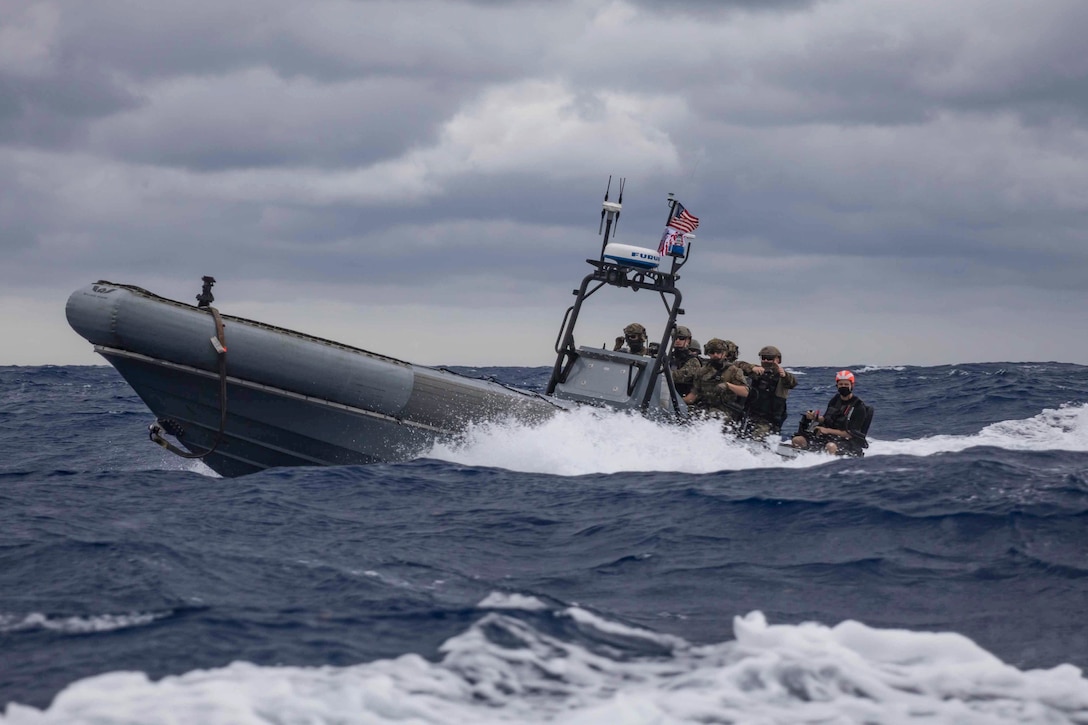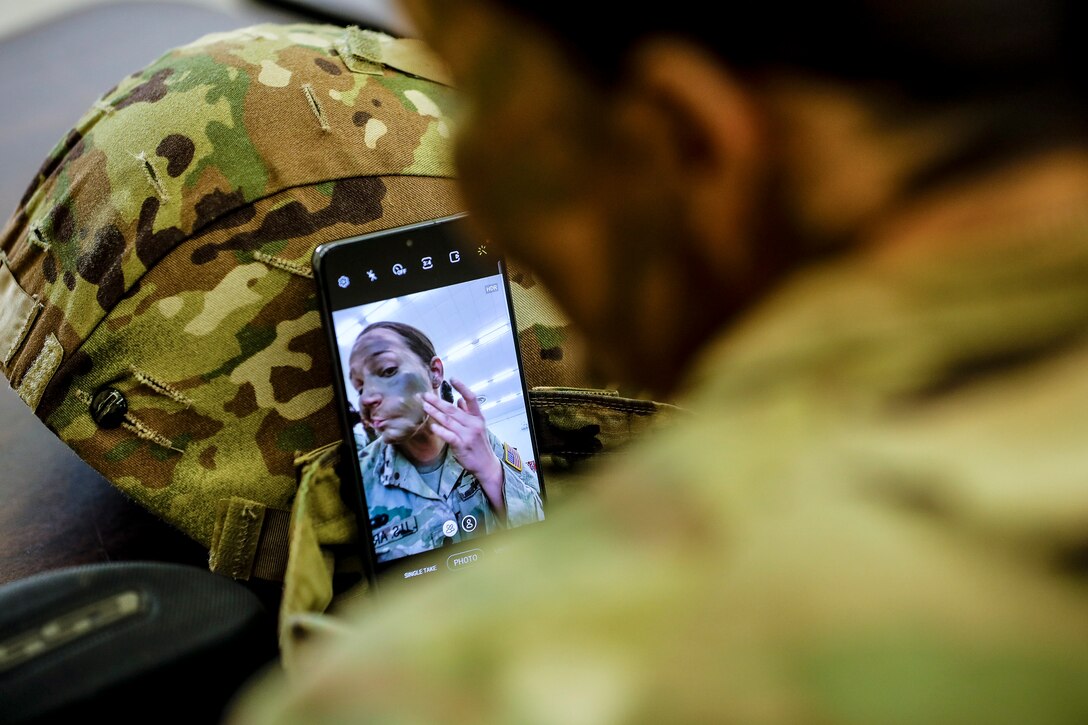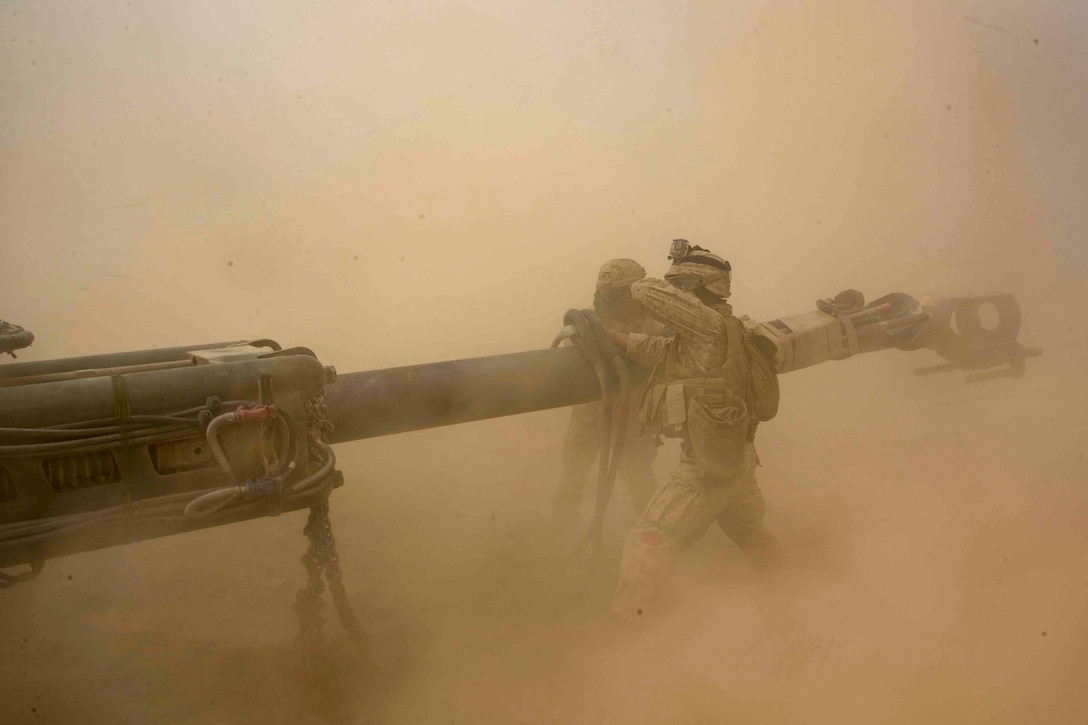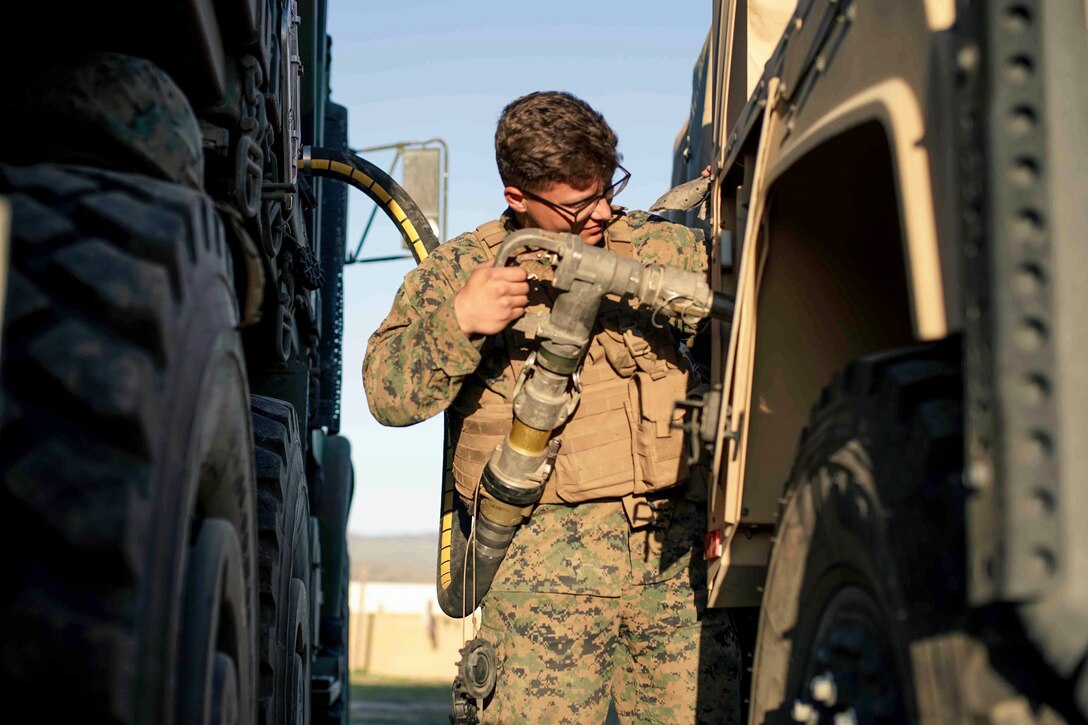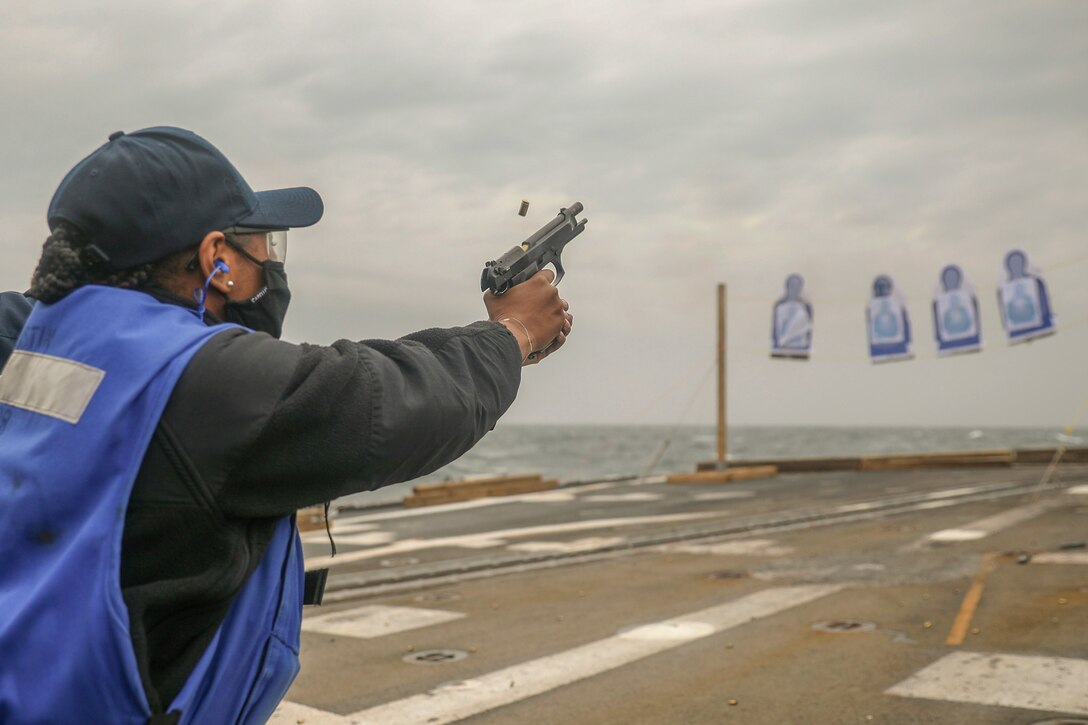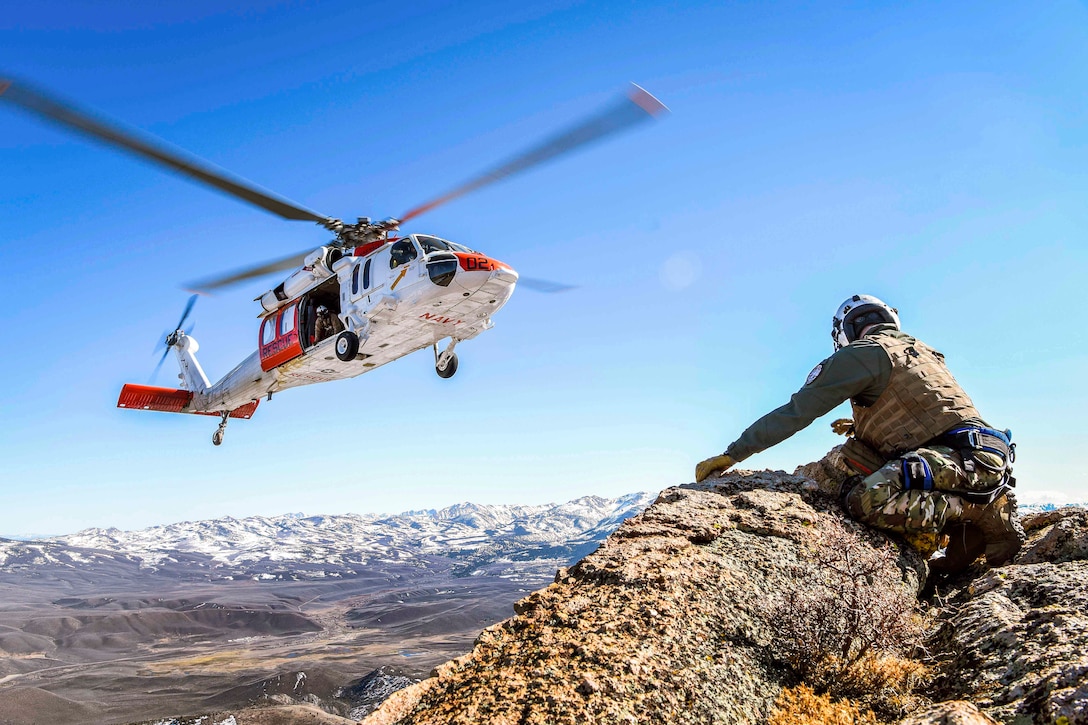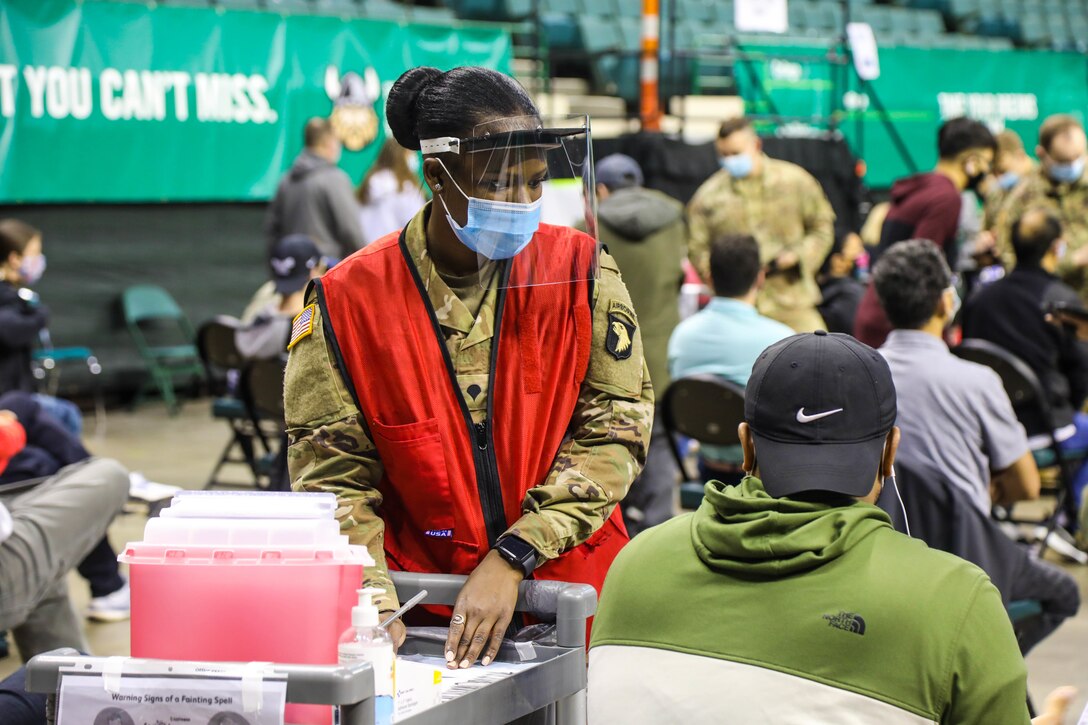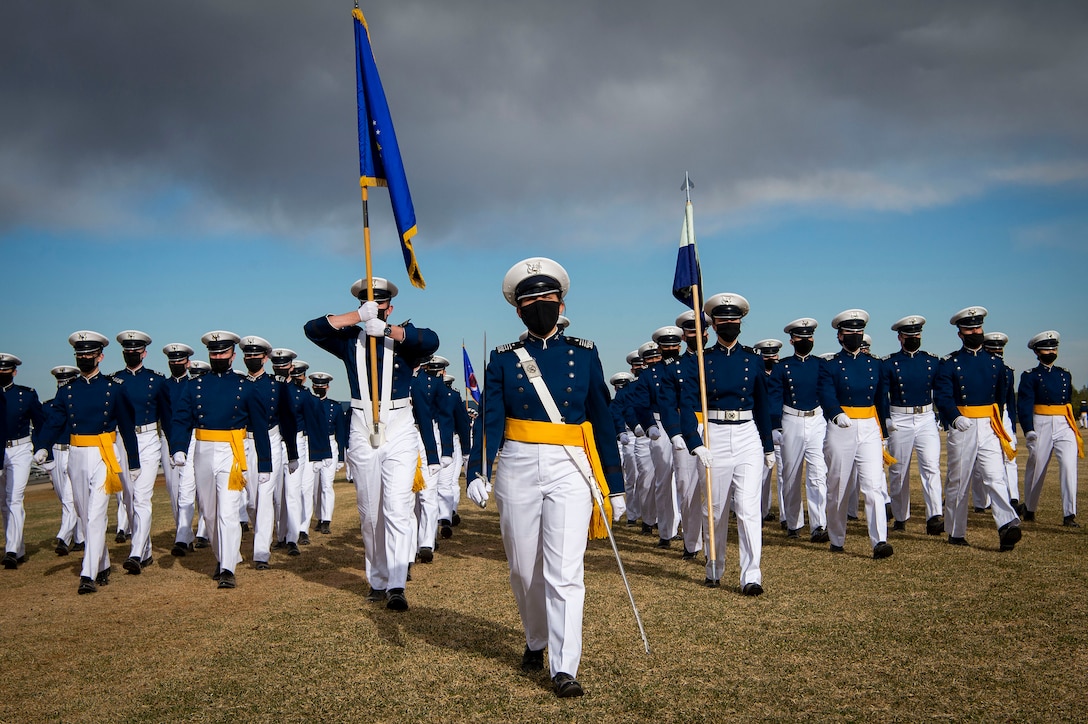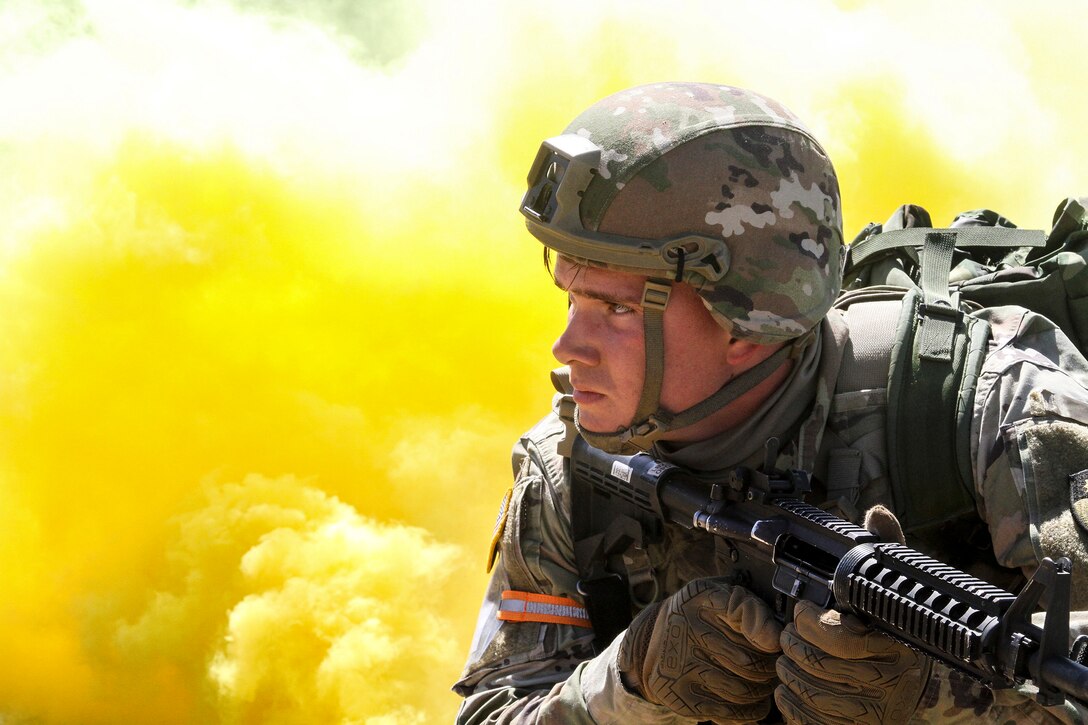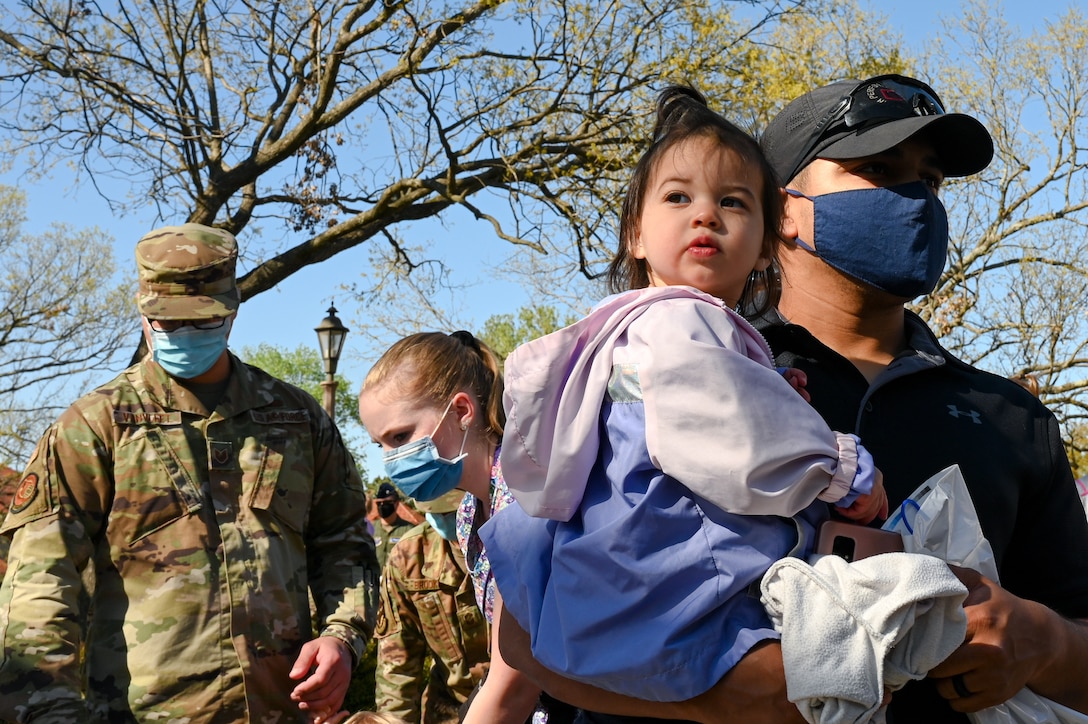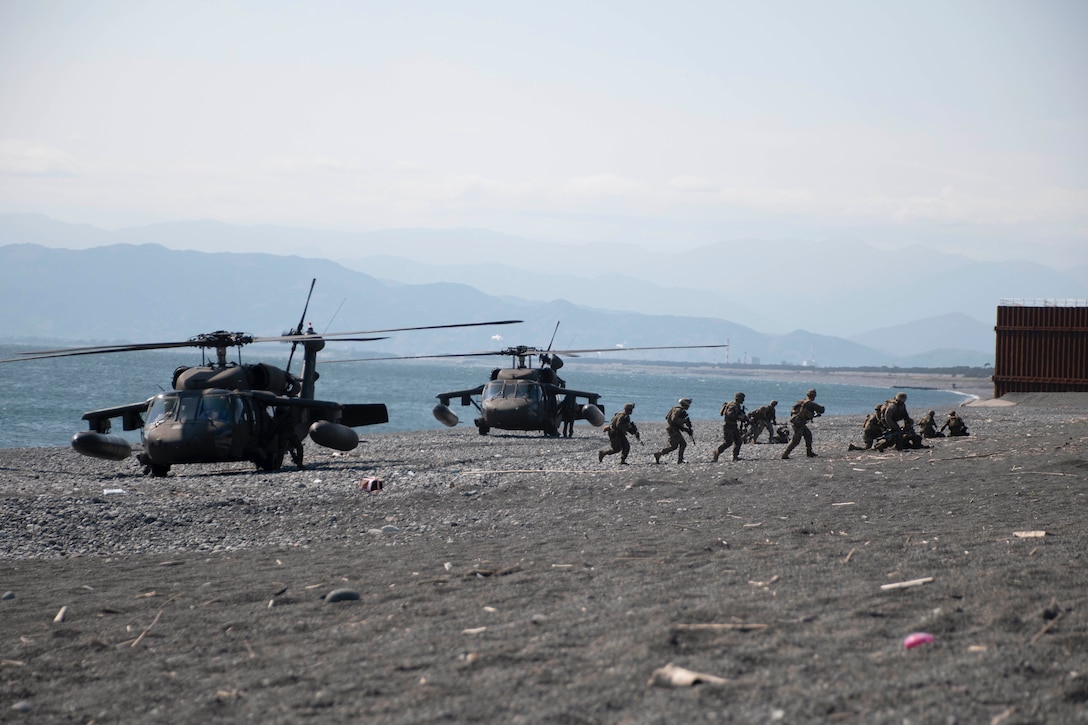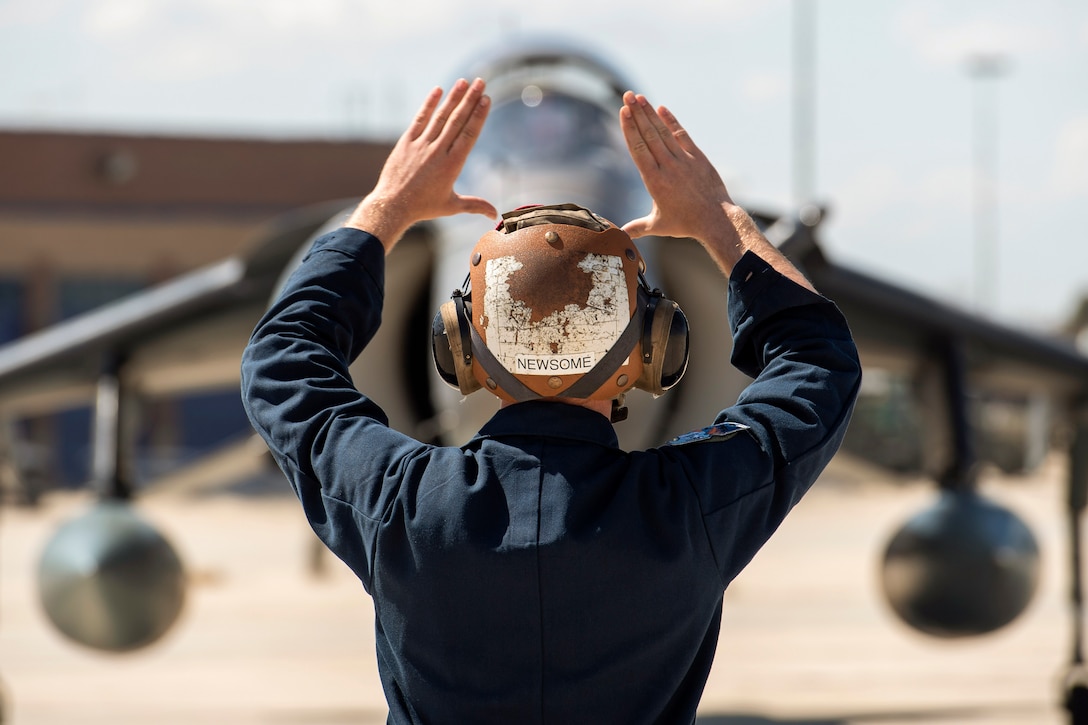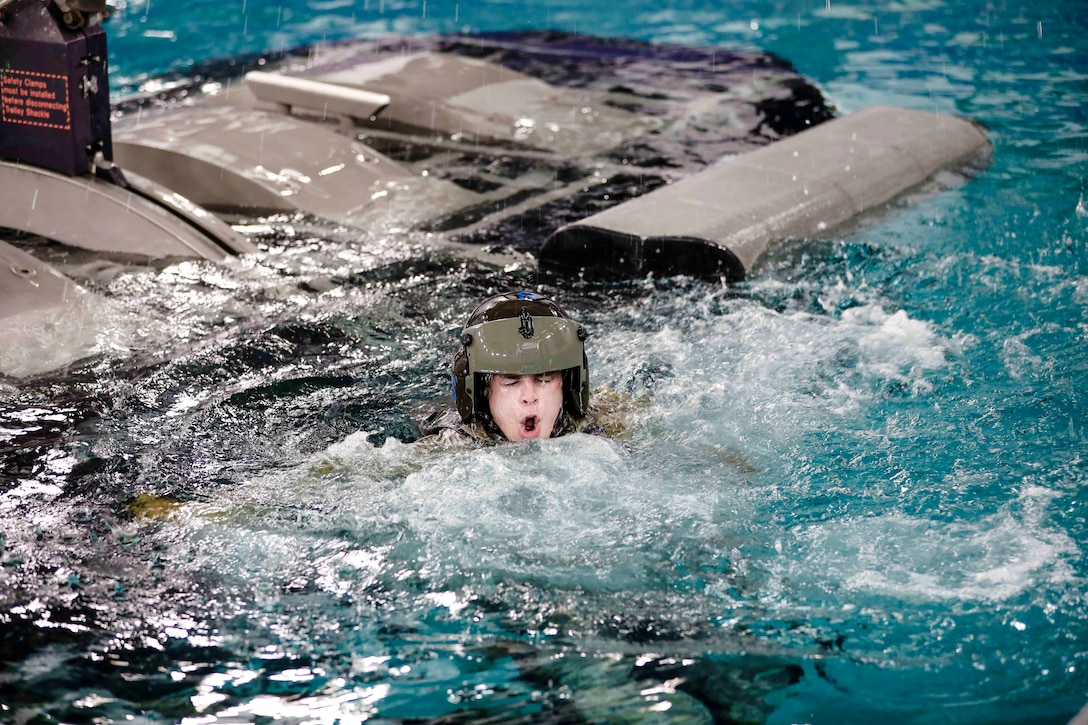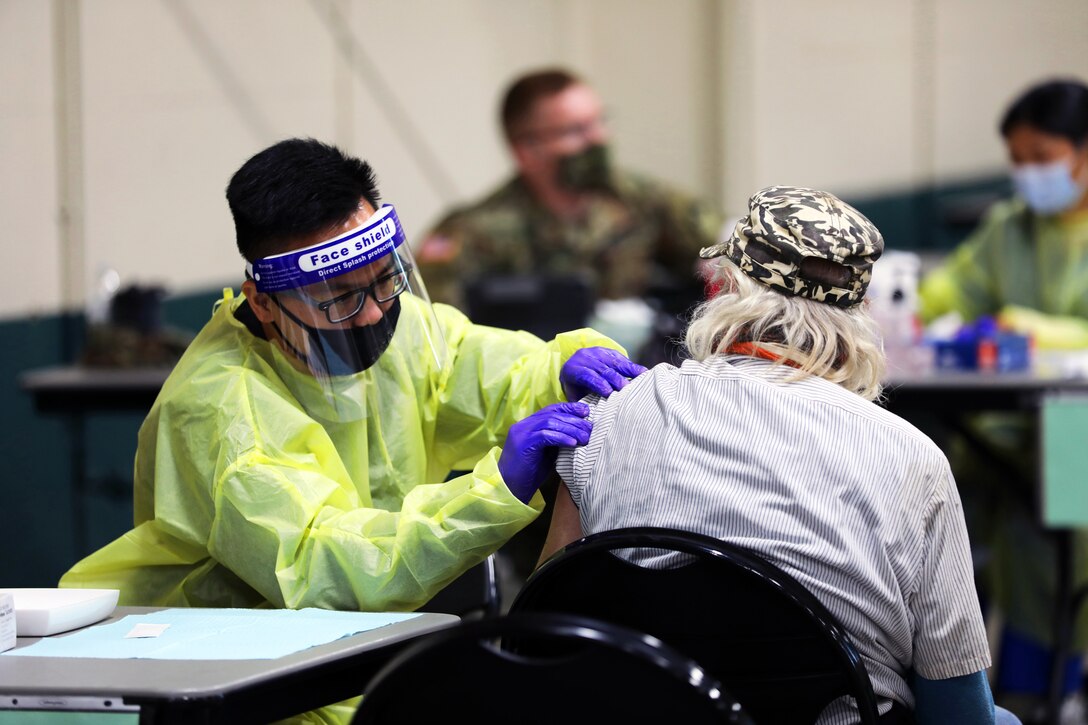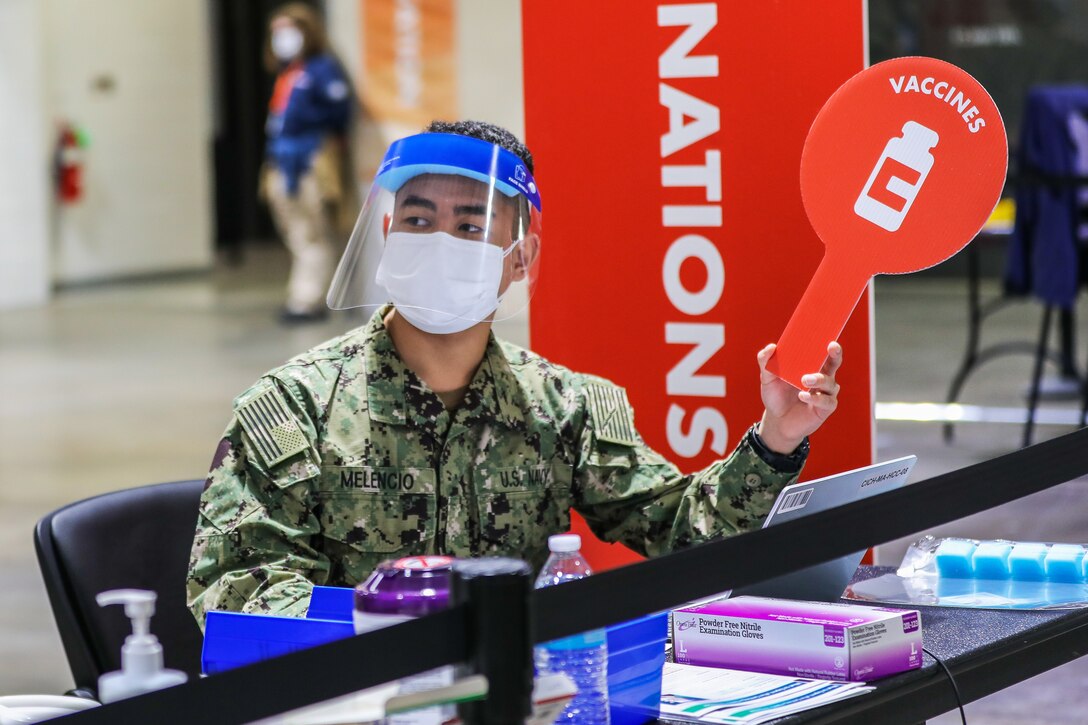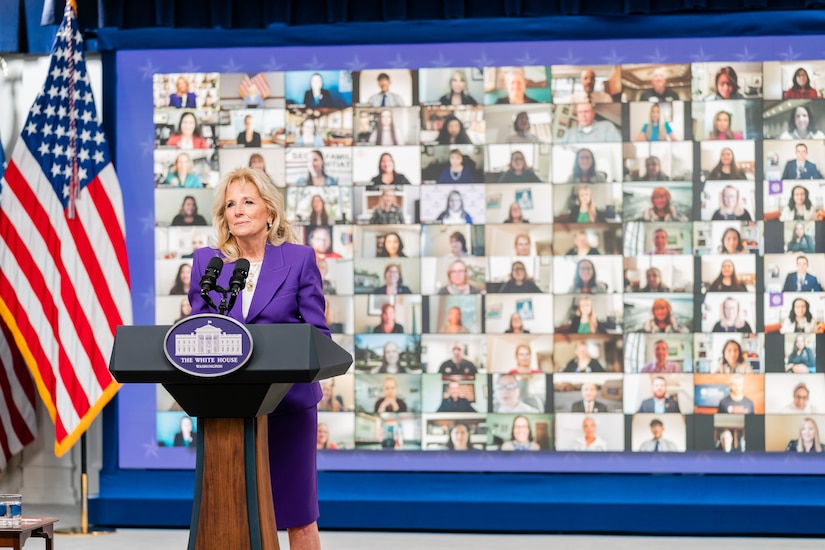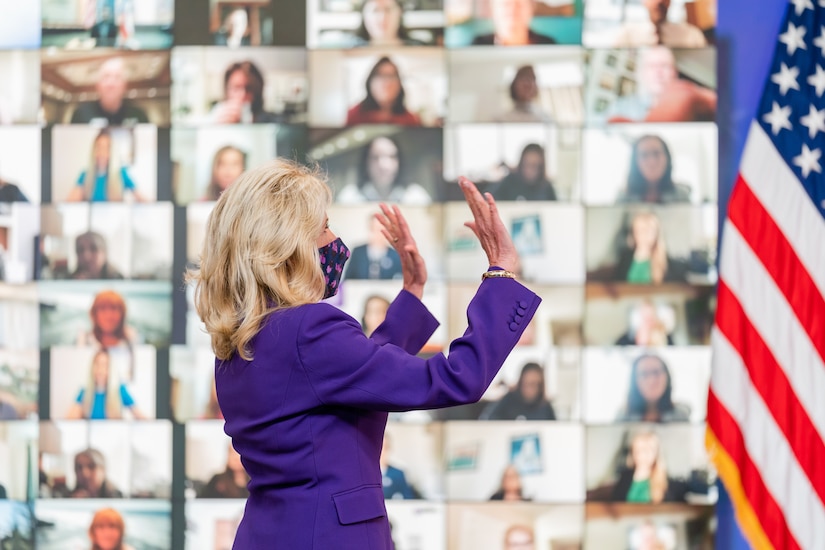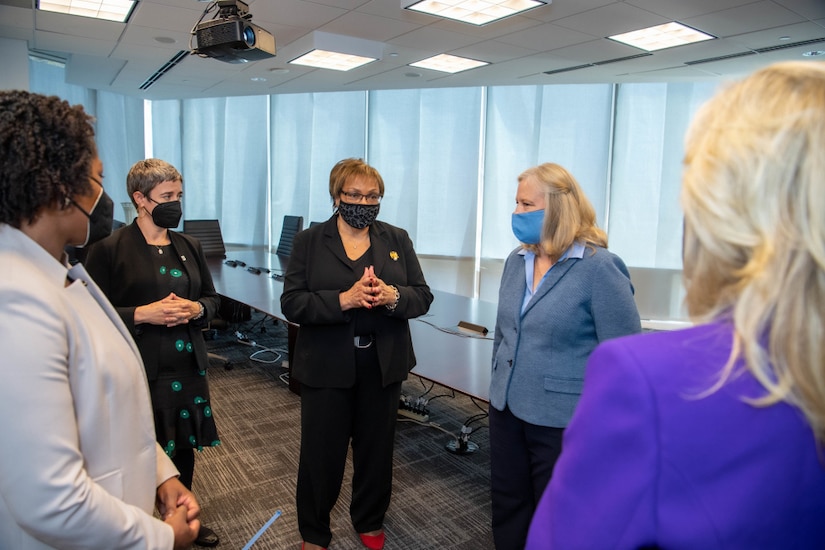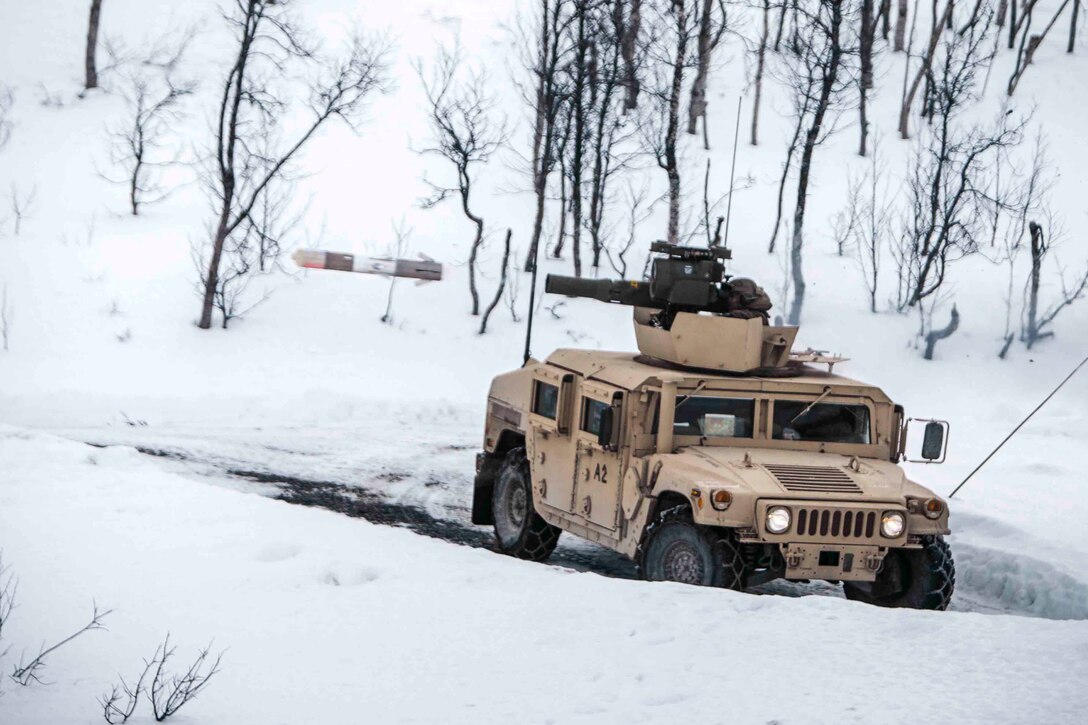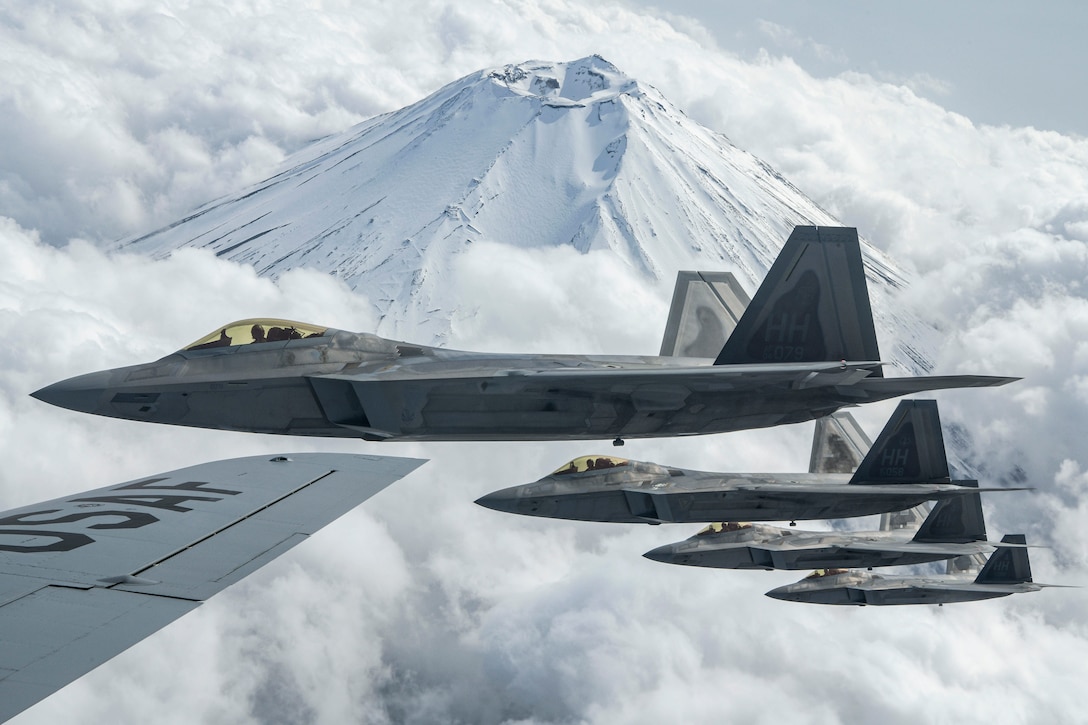April 9, 2021
PRESS SECRETARY JOHN F. KIRBY: Okay, a couple of things at the top. As you all remember, back in February, the Secretary of Defense directed a stand down across the force to occur within the following 60 days -- in the ensuing 60 days -- to address extremism across the DOD workforce. While we are still reviewing, of course, what we learned there, there are some immediate actions that our subject matter experts here in the department have identified as critical initial steps and the Secretary has approved. I believe you'll be seeing the -- the specific memo here posted immediately.
But to give you a summary, today, the Secretary's directing several immediate actions, as well as and including the establishment of a countering extremism working group as we continue to address this issue in an active manner.
The immediate actions -- again, all of this is in the memo that you'll be getting, if you don't have it already -- consist of a review and update of the department's instruction 1325.06, -- the definition of extremist activities in -- in that instruction. We're going to update -- provide an update to service member transition checklists, review and standardize screening questionnaires for accessions for new personnel, and we're going to commission a study -- the Secretary has commissioned a study on extremist behavior within our total force, to include greater fidelity on the scope of the problem.
The working group will be led by Mr. Bishop Garrison, the senior adviser on human capital and diversity, equity and inclusion, and will oversee the implementation of the immediate actions that I just described above, as well as the development of mid-term and long-term recommendations for continued engagement on this issue.
In the memo, which you will see, there are lines of effort for the working group. I'll point you to that, to go through that with -- in -- so you can see exactly what the -- the lines of effort are for the working group going forward. A report of additional mid-term and long-term recommendations and the status of implementation of those aforementioned immediate actions will be provided by the working group no later than 90 days from its first meeting, which will occur on or about -- on or about the 14th of April.
Now, shifting to the Indo-Pacific region, we remain concerned by the massing of Chinese maritime militia vessels in the Union Bank area of the South China Sea and China's efforts to impede the lawful rights of our treaty ally, the Philippines. The United States stands by our ally and we remain firmly committed to preserving a free and open Indo-Pacific that is rooted in international law, as reflected in the Law of the Sea Convention.
In support of our long-standing commitment to freedom of the seas and to regional security, as well, the Theodore Roosevelt carrier strike group and the USS Makin Island amphibious ready group are undertaking high end training and operations in the South China Sea this week.
As we've said many times before, the United States will continue to fly, sail and operate wherever international law allows and we will support the rights of all nations to do the same. This is not going to change. And with that, I'll start taking questions. I think we have Lita on the phone.
Q: John, just a couple of things on this -- the memo today. Can you give us a better description, or I don't know if it -- it's -- you're sending it out with it -- with the memo but I haven't gotten the memo yet -- a better description of this screening questionnaire. Is this going to be required for all recruiting, for all of the services and services that -- to tweak it or not, or just, I guess, a few more details on that and sort of what -- what you're looking for?
And secondarily, did any of these sessions or did anything come up regarding the renaming of bases or other service buildings, et cetera? Is that an issue that was discussed at all or that came up in these sessions? Thanks.
MR. KIRBY: So thanks. On -- on your question about the screening questionnaires, what we're specifically doing in the immediate actions is requiring the secretaries of -- of each of the military departments to update and standardize accession -- that's recruits -- their screening questionnaires to solicit specific information about current or previous extremist behaviors. Such -- such questions should be designed for two purposes -- one, to gather actionable information in the short term to ensure that only the best qualified recruits are selected for services, and two, to clarify that any demonstrably false answers provided in response to that questionnaire could form the basis for punitive action for fraudulent enlistment. I hope that answers your question.
On the second question, Lita, I did have the opportunity to sit in with the secretary when he met with the service secretaries today to get their feedback about the stand-down. And that was not an item that they highlighted for the secretary. That's not to say that in every case, in every unit -- I mean, some of the -- the stand-down training was done all the way down at the platoon level, so it would be difficult to know what was discussed in each and every session conducted across the force, but the idea of the -- of the bases or installations being named for Confederate leaders was not something that bubbled up to the feedback that the secretary got today.
Q: All right. Just to follow up on the screening --
MR. KIRBY: I'm sorry, Lita, did you have another one?
Q: Yes, yes, to follow up on the screening question. You said gather -- potentially gather actionable behavior, so is this the questionnaire that's going to be kept that future behavior would be checked against? And is there any way to, I guess, do some sort of a screening of already enlisted personnel?
MR. KIRBY: These screening questionnaires, the immediate action that we're taking today is really about having the services standardize, that we want them to work together to standardize what that screening questionnaire looks like, the kinds of questions that are on there.
It wasn't about -- and I apologize if I -- I was reading right from the memo, I don't think it -- I don't know -- didn't mean for it to be confusing. It's not about anticipating future behavior, it's allowing for accountability by the department should it be determined that in answering the questionnaire an applicant answered falsely, and giving us that the flexibility to be able to hold somebody accountable for false answers on that questionnaire.
So this is really about getting the services aligned and getting the questionnaires to deal with this issue and to deal it in an equitable way, a way that is consistent across the services and their recruiting platforms. Does that answer your question, Lita?
Q: Yes, thanks.
MR. KIRBY: Tom.
Q: Thanks, John. Can you give us a sense of what the secretary heard from the service chiefs?
MR. KIRBY: Sure.
Q: Anything jump out at him that he heard? Anything trouble him? And just your general sense of --
MR. KIRBY: Yes.
Q: -- anecdotes. And also, when you say review and update the definition of extremist activity, what -- if you look at maybe barring simple membership in extremist groups, which, right now is allowed?
MR. KIRBY: That is something that the secretary has indicated that he wants the working group to look at. That's not something, Tom, that's in the immediate actions, which is an updating of the actual instruction that exists right now. But he certainly is willing to have the working group take a look at this and see if that makes sense.
And as for the feedback, I mean, first of all, each of the services reported completion of the stand-down. Obviously there were some minor exceptions to that, in particular with Reserves and Guard units that have asked for, and have received extensions, different time frame extensions based on the services. And the services can speak to that. But by and large the service secretaries reported, you know, 100 percent completion of the stand-down, again, with some exceptions.
I don't want to speak for them, but it was clear to the Secretary that they took it seriously, the stand-down, that they believed their people took it seriously across the force, that the listening sessions that the secretary asked for was particularly fruitful and valuable. And I, myself, found that the same when we did our stand-down here in Public Affairs, that those listening sessions were really critical. That seems to have been the same feedback that the secretary got from the services. I think it was -- one consistent thing that he did here was that the force wants better guidance. The men and women want better guidance about what extremist activity really is which is again totally in keeping with what we're going to try to do here with his instruction and through the working group and wants that guidance to be as clear as possible.
So it is really a consistent theme that he heard was a hunger for more information and context about what we're talking about here.
Q: Do you have any more detail about problems they see -- do they see problem from extremism in the military? Or racism? I mean anything that he heard that kind of jumped out at him?
MR. KIRBY: I mean he did get -- anecdotally the service secretaries did share with him what they -- what bubbled up from the ranks in terms of what they heard. And -
Q: And what was that?
MR. KIRBY: Well I don't have specific stories. It wasn't like they gave him a specific story or anecdote, they just reinforced for him that in many, not all, but in many cases people did express that they understand that this is a problem, that some of them have experienced, personally I found that in my own stand down that we did here at the Pentagon.
I heard quite a few personal anecdotes about experiencing it and I think that was reflected across the force.
Jim.
Q: Was there any indication of the extent of the program? Did the service secretaries talk to the Secretary about how deep they think this might be in the ranks?
MR. KIRBY: I think again -- one thing that was reinforced by the services to the Secretary, is something you've heard him say before and that's that the vast majority are serving with honor and dignity and upholding the oath and living by the core values of the military. I think that was -- that certainly came back to the Secretary that the men and women of the force, military and civilian, by in large, by vast majorities are not espousing this ideology and they're not conducting themselves in accordance with this ideology.
But that there is a corrosive effect; though the numbers are probably small that it is -- that there is a corrosive effect. And that's why when you -- well one reason why. When you look at the memo one of the things the working group is going to do is try to get a better handle on the data. And try to improve our partnerships and relationships with particularly law enforcement to try to make sure that we have a better sense of what that scope is.
And, again, in the memo you'll see he’s commissioned -- I think I put this actually in one of the immediate action is to commission and extremism study again to try to see what we -- what we can do get a better -- get a better grasp of the situation.
Let me go back to the phones, here. I've got a lot of folks to get through so we'll just -- we'll keep at it. Nick from PBS.
Q: Thanks, John. There's the third bit of immediate actions we haven't asked about is the transition checklist. This is a description of something of training for service members as they retire or separate on how they might be targeted by extremist groups. Can you give us a little bit more about that? What has been found about the level of recruiting by extremist groups on recently separated or recently retired? And is there a sense that those recently retired or separated are not getting enough either support or information upon separation or retirement about possible extremist recruitment?
MR. KIRBY: There's definitely a sense, Nick, that more needs to be done to educate and inform transitioning members about who and what are waiting for them on the other side. In the last administration they did an extremism study that ended, I think, in the fall, and in that report, it said very clearly that we have evidence that some extremist groups are actively recruiting active-duty members as they get ready to transition because they value their leadership capability, their organizational skills, their weapons training.
So we know it's happening, and so I don't think that's really in dispute. What we need to do and focus on more is, how do we prepare transitioning members to be aware of that interest in them, and to know what it looks like and what it feels like, what it sounds like when these groups are trying to recruit them.
So we have asked again in the immediate actions for all the services to add provisions into their transition checklist, all the things that, you know, when you get ready to leave the service, that we make sure you're ready for it when you go to civilian life: what your medical benefits are, what your educational benefits are, how to buy a new house. There's a whole list. I mean, there's, in -- in some cases when you retire they even tell you how to pick a suit and a tie. But there's nothing in there -- not consistently, anyway -- about this particular problem.
And what the secretary wants to be included in that transition checklist for all the services is an acknowledgment that this is a possibility, and that -- and that these groups, many of them, are seeking the kinds of skills, the kinds of leadership that our men and women exude when they're in service and getting ready to transition into civilian life.
Q: And on that item, what can you do to guarantee that it's not literally a check the box; that this is a robust effort of education and facilitation for recently-retired or separated that goes just beyond checking a boxes; that's actually a real level of education, of giving them what they need?
MR. KIRBY: I've said that the -- the military departments will come back to him and keep him informed about what this training is going to look like. I mean, he's very interested in knowing that it isn't, as you rightly pointed out, and I can see if he, you know, when we talk about a transition checklist I could -- I understand your questioning coming from, well, does that just means you check the box? And no, of course not. And he expects that the service secretaries will keep him informed about what the training looks like, and he, you know, he doesn't want to micromanage that process. He just wants to make sure that all the services are taking a serious look at this as people get ready to transition. And as I said, he expects them to report back to him and keep him informed about what that training is going to look like.
Okay, I went on the phone, so Abraham?
Q: Thanks. As far as the study, do you have any details about like how, for example, they would be gathering data? And then also --
MR. KIRBY: What -- what study?
Q: For the study that's -- that's commissioned.
MR. KIRBY: Yeah, yeah.
Q: The study on extremism that's commissioned. You know, how would you -- is there any ideas on how they would go about gathering data about how many -- how many extremists or people who hold extremist ideology -- ideologies exist in the -- in the force? And then also, there've been concerns from Congress that Catholic and evangelical service members would be targeted. Was there any concern brought up today about how to assure that -- that those folks would not be specifically targeted by any new actions?
MR. KIRBY: I did not hear concerns expressed by the service secretaries with respect to religious beliefs at all. And as we said, this has absolutely nothing to do with what God you worship, or whether you worship at all. This is about the kind of extremist ideology that is based on extreme hatred or discrimination on, based on ethnicity and discrimination based on someone's personal background and not about religion. So that -- that wasn't a concern that we -- that the Secretary heard today at all.
And then on your question about data, this was largely about helping us latch up better with civilian law enforcement and what they're seeing, cause not all offenses which could be related to the behavior of -- that is inspired by extremist ideology occurs on base or on post or on duty. So it's about getting a better sense of the universe of the kinds of cases that are out there.
This is not about, you know, being the thought police, Abraham, it's not about identifying, you know, you, as an individual, and what's in -- what's in between your ears. It's about what you do with what's between your ears, it's about the behavior and the conduct that is inspired by or influenced by this kind of ideology.
Obviously, without question, we would want and expect that anybody who raises their right hand and takes that oath and joins the military, civilian or military, that they're going to live by that oath. And as the Secretary has said, 99.9 percent do, but there's no way of knowing, you know, when you're just looking at somebody, what they believe.
What we're talking about is about what they do that runs contrary to that oath or the values that they act on that are contrary or inimical to what we believe our core values are.
Q: If I might, the -- when you say "latch up with law enforcement," what -- what's not being done now that could be --
MR. KIRBY: There's already been coordination between federal law enforcement and the military in terms of a better sharing of information of individuals being -- military-affiliated individuals being investigated for crimes that are believed to be inspired by extremist ideology. So some of this work is already going on.
I think what the Secretary wants to do is institutionalize that cooperation and deepen it and broaden it.
Q: Could I very quickly follow up on that?
MR. KIRBY: Yeah.
Q: When you talk about working with law enforcement, what about the Pentagon's own statistics? Like, someone's kicked out for a variety of reasons, one of them could be extremist behavior but it -- it -- that box is checked, extremist behavior, is there a way you guys can -- can work that on your own side, your own data?
MR. KIRBY: Again, I think -- I think that's one of the things that he's going to want the working group to look at and see if it's even -- if it's even possible. I mean -- but that's one of the lines of effort of the working group. Yeah, Joe.
Q: On a different topic, on Ukraine, as you may know, Turkey has said today that the United States -- that you -- they sent two warships into the Black Sea. Could you give us more details about that and do you consider the move as a message to the Kremlin?
MR. KIRBY: As you know, Joe, we routinely operate and conduct operations in the Black Sea and throughout the European Command AOR. And as you also know, I'm not going to forecast or -- or speak about hypotheticals or about future operations. This is a normal evolution for the United States military and we obviously coordinate the entry into the Black Sea through the Montreux Convention with Turkey, but I won't speak to the press report that you're referring to specifically.
Q: So -- so you don't claim the -- sending the two warships into the Black Sea, to the tensions of the eastern side of Ukraine --
MR. KIRBY: First of all, I'm not going to confirm the Turkey press reports that you're referring to. We routinely operate in the Black Sea. We just had some ships in there just recently. That’s not anything new.
Again, this goes right in keeping with what I said at the topper with respect to the South China Sea, where we will fly, sail and operate wherever an international law permits us to do so. That's what this is about. And clearly, we take our obligations throughout the European Command area of operations very, very seriously.
Q: A quick follow up, what's the latest assessment from the Pentagon in regards to the amassing Russia forces on the eastern side of Ukraine?
MR. KIRBY: It's the same as it's been since we've been talking about it, Joe. We would like better clarity. We would like the Russians to be more transparent about what it is they're doing with this force buildup in Crimea and also along the eastern border of Ukraine. It's not exactly clear, we don't believe it's conducive to stability and security there, and we call on Russia, as I have said in the past, to be more transparent about what they're up to, what their intentions are.
Q: A follow up?
MR. KIRBY: Yeah, go ahead.
Q: Secretary Austin, in his visit next week to Europe, will be seeking maybe a united action from the NATO toward Russia?
MR. KIRBY: I'm not going to get ahead of the Secretary's schedule. I think you saw the trip announcement last night. It will include a -- a stop in Brussels and a chance to meet with NATO leaders, particularly and specifically the Secretary General. He's looking forward to that.
There are a number of regional and global security issues that I have full expectation he'll address but I'm not going to get ahead of that meeting or those meetings until they've happened, okay? Let me go back here. Let's see. Travis from Bloomberg
Q: Hi, John, thanks. India's Foreign Ministry issued a statement today saying that the USS John Paul Jones passed through the country's exclusive economic zone without permission, and it said that it registered concerns with U.S. diplomats. I'm just wondering does the Pentagon believe that the destroyer was within its rights when it was in the EEZ? And do you have any message for India? Thanks.
MR. KIRBY: What I can tell you is that the USS John Paul Jones, a Navy destroyer, asserted navigational rights and freedoms in the vicinity of the Republic of the Maldives by conducting innocent passage through its territorial sea, in normal operations with its exclusive economic zone, without requesting prior permission and that's consistent with international law.
Again, we will continue to maintain the right, indeed the responsibility to fly, sail and operate in accordance with international law. Yes, ma'am?
Q: A question on the President's budget request. It included a section on shipbuilding and it said "to reassure allies and signal U.S. resolve to potential adversaries." So I was wondering if you can talk more about the importance of investing in shipbuilding to counter China?
MR. KIRBY: I would -- I would just -- let's back up a little bit from that and -- and -- and not necessarily make shipbuilding all about one nation or one nation-state or one threat. The Secretary believes that our Navy remains the most powerful Navy in the world, and under his leadership, he wants it to stay that way, and that means -- and you've heard the Secretary talk about this, that that means making sure that in the maritime domain our Navy has a proper mix of capabilities across the spectrum to defend this country at sea, on the sea and under the sea.
And I'm not going to get ahead, as you might imagine, of the budget lay down or specific programs, that's just not going to happen today. But I can assure you, as you saw in our statement, that certainly shipbuilding is something the secretary is going to be focused on, again, with a mind towards making sure we have the right mix of capabilities now and in the future to defend this country on and under the sea, okay?
Megan.
Q: Secretary Austin's assertion that 99.9 percent of the force does not engage in any sort of extremist behavior belief is extremely unscientific given that the Pentagon, the services know that they don't really have any data that really covers the spectrum of this. Is there another way that you would try to characterize that?
MR. KIRBY: It's a colloquialism, Megan. He's basically trying to make the point that -- that we still believe, and I think the feedback today reinforced that, that the numbers of people in the force that espouse this ideology are very small. But he has also said right after making that colloquialism that even a small number -- first of all, you know, the number ought to be zero given the fact that you take an oath to defend the Constitution of the United States, that you make a promise to the American people about what you stand for.
But even though the number is small, it can have a corrosive outsized effect. And that's the larger point he is trying to make.
Q: I have a follow-up, the Guard and the Reserve have until June to complete their stand-down. So I assume General Hokanson has been part of this discussion, but what sort of feedback did he have given that his troops have not necessarily all been able to weigh in at their own stand-down?
MR. KIRBY: Well, the meeting today was with the service secretaries. And they did brief the secretary on sort of the progress of Reserve and Guard, that you're right, they have extensions in place. And each service with a Reserve and a Guard component had a different set of expectations for when those were going to be complete.
But the service -- and, again, I don't want to speak for the service secretaries, but they did roll up what they've been learning from their Reserve and Guard components into their larger reports to the Secretary. And, again, I gave sort of an out-brief here at the top, that it is a, you know, recognition that it is a problem. It's not a problem that is pervasive across all ranks and all the force. And that they too appreciated the small listening sessions and the chance to talk back. And also the recognition that the forces, I mentioned to Tom, clearly wants more clarity about what extremist activity actually means and, you know, what they can do or should do in terms of how to report that, how to act in that space, okay?
Let's see, Sam, from USNI.
Q: Hi, John. Two things on the South China Sea situation. The representatives from the Philippine Defense Ministry said that they were pursuing active communication with the U.S. to -- as part of a mutual defense treaty, how those conversations have been going, can you just, you know, give a flavor if you all have been in communication or not with Manila?
And then number two, the ships that the T.R. in Makin Island encountering from the Chinese navy or the maritime militia or the China coast guard, any one of those three, have those interactions been professional or are they moving towards not? Thank you.
MR. KIRBY: I haven’t seen any reports that indicate that any interactions have been unprofessional or unsafe but I'd point you to the service, in this case the Navy or the Indo-Pacific command for more information. I also don't have any specific communications with our treaty allies of the Philippines to read out to you today. But as I said at the topper we take our treaty commitments seriously and certainly any attack on the Philippines would certainly warrant us acting on those commitments.
But we're just not there yet and of course nobody wants to see this comes to blows or to result in any conflict.
Jeff, Task and Purpose.
Q: Thank you. If I heard you right there is no plans in the immediate future to address the issue that active participation in an extremist group doesn't just mean that if you're a member you can be involuntarily separated. I'm wondering this seems to be an easy fix just change a couple of words from active participation to membership. Why hasn't DOD fixed this already?
MR. KIRBY: I guess I take issue with your characterization of this as being an easy fix. I mean it may seem like something with a stroke of a pen you can do. But if -- but the nature of these groups change all the time and new groups pop up and old groups die off and they morph into something else.
And the other thing, Jeff, is that's not just about group membership. It's about and I keep coming back to this in my answer to Abraham, it's about the ideology and the conduct that that ideology inspires. And when -- and you know this, Jeff, and you've been covering this building a long time. Some of this radicalization occurs on an individual level. And some of it happens based on interaction in social media circles and some of it happens with interaction with peers and colleagues. And not all those peers and colleagues are in the ranks.
I mean we sometimes we talk about troops like they're some insular body and they don't interact with anybody outside the military and that's just not the case. So it's not quite so simply as that, Jeff. And just to follow-up on that, as I think in my answer to Tom, certainly I think this idea is going to be something the working group's going to look at.
But I wouldn't predict or try to anticipate any specific finding that they might have. But the Secretary wants the working group to take a look at these groups themselves. And whether that's something that's worth thinking about. But it's because it's not easy; if it was easy, then we would have put it in the list of immediate actions. But it's because it's not and it does complicated and it does tend to ignore this individual radicalization that can go on that it's not in the immediate actions.
Q: What data does DOD have on the number of service members who have been involuntarily separated for extremist activity?
MR. KIRBY: I don't have that data handy here, Jeff. And as you well know not all separations from the military are handled at a central level. Largely, mostly they are handled at a more -- a lower level administratively and sometimes it's not always indicated with great specificity why a member might be separated. There are -- obviously there's many reasons to do it. Usually it's in terms of violations of the UCMJ or repeated violations of the UCMJ.
But it doesn't always have to indicate extremist ideology or extremist behavior. Sometimes it does, sometimes it doesn't. As I said many of these of people they like living in the shadows and you're not always going to know what inspired them to act. Or what inspired them to commit a crime or a violation of the UCMJ.
Tony.
Q: A question on the Israeli trip -- the stop that the Secretary is making, is he going to be discussion with the Israeli ministers there, the -- the new lay down, where CENTCOM has now Israel and the rest of the Middle East under its purview?
MR. KIRBY: That's not a goal for going, Tony. I mean, I think it's about making sure we reaffirm our commitment to our strategic partnership and to Israel's qualitative military edge and to talk about a range of regional security issues, to consult with our Israeli counterparts about their view of regional security, and I think he's going ahead of Remembrance Day and he looks forward to honoring fallen Israeli soldiers who have fought so bravely and defended their country.
He's not going there specifically to address the unified campaign plan in terms of, like, where they sit, in what combatant command that they belong to. I don't expect -- just to put a fine point and a period on this -- I don't expect the Secretary to challenge or to change the decision that was made prior to him coming into office, to move Israel into the Central Command region, in terms of the UCP guidelines. I don't expect any change in that.
Q: -- The Global Force Structure Review, Global Posture Review, where does that stand by way of completion? And might that inform the F.Y. '22 budget since that's still in -- in flux, or is it more likely, the '23 through '27 plan?
MR. KIRBY: I kind of, you know, want to say all of the above, Tony. So the Global Posture Review is ongoing and we expect it to be complete mid-summer-ish. That work is ongoing and I don't -- I don't want to overstate the effect it's having on the '22 budget discussions but -- but clearly, anything we learn as -- that process that we might think could inform this first budget cycle, I think the Secretary and the Deputy Secretary would be open to that. That's not the goal, though, and the Global Posture Review is again, it's a work in progress.
That said, when it's complete in the summer and when the Secretary's had a chance to review it and approve it and send it up to the White House for their approval, you know, I would fully expect that that would also help inform follow on budget and program decisions going forward, cause it is very much about resourcing -- resourcing the strategy, and resourcing, as you well know, does get right down to the program level.
(CROSSTALK)
Q: -- Middle East --
MR. KIRBY: Yes.
Q: -- and you can't focus on China to the degree -- the degree that you want, so that's why I asked the question.
MR. KIRBY: It will -- it will certainly inform subsequent budgets. Yep. Let's see -- Faisal from Al Jazeera?
Q: Actually, you answered my question before. Thank you.
MR. KIRBY: I'll give it another -- okay. Steven from -- I can't read this, Brook, from MI.com?
Q: (OFF MIC) Military.com.
MR. KIRBY: Military.com.
Q: Yeah, thanks. I'm curious about the line of effort regarding the insider threat program. Can you talk to me a little bit about how much these programs right now are -- are dealing with things like insider threats? Like, is this something that insider threat programs do already and you're trying to improve them, or have these kinds of programs not covered issues such as the type of extremism in question?
MR. KIRBY: Yeah, so the specific line of effort that the working group will look at is to determine how the department should facilitate better information collection -- this gets to the issue about data -- and sharing among the -- the service insider threat program. So the services have these programs.
So one of the things I think the working group wants to look at is how well are they interconnected and how -- how robustly are they sharing information and best practices, to include, again, data collection through partnership with law enforcement organizations, security organizations, as well as commanders and supervisors.
Q: So is that to say it's kind of unclear right now, the extent to which these types of programs are addressing the violent extremism issue?
MR. KIRBY: I think the Secretary wants them -- he wants to -- to take a look at the consistency among them, to see the degree to which they are, in fact, addressing this particular challenge, and again, to -- to improve the sharing of information between the services and also between us as a department and law enforcement, but that's why this particular line of effort was nested inside the working group, because it is an issue that -- -- to the point of your question, that I think the Secretary believes we need a little bit more clarity on, and that's going to take some time.
Q: Thank you.
MR. KIRBY: Yes.
Q: Thank -- thank you. Given that satellite emissions in the North Sea, in the Arctic that have recently come to light, and then pressures in Ukraine, with Soviet troop buildups down into Crimea, Ukraine, and then down into Georgia, where there is continued pressure from the Soviet Union -- sorry, from Russia -- I'm an old style -- from Russia down there, has any of this congealed into thinking that there needs to be any sort of buildup or response or a posture change or has NATO expressed any requirement, any desire for support -- additional support from the U.S. military?
MR. KIRBY: I'm not aware of any requests from the alliance about this. I mean, obviously and I've been talking about this all week -- we're watching particularly this force buildup along the eastern border with Ukraine and in Crimea, the -- as concerning and certainly not conducive to a sense of security and stability in that part of the world, and we want better clarity on that.
We're also mindful and, I've talked about this in the last several days -- of other Russian aggressive activities in terms of air intercepts and missions of that sort, that again are not conducive to security and stability there or -- or elsewhere around the world where they occur.
And I'm not -- certainly not going to get ahead of specific policy options or operations but as the Secretary testified and has talked to many times, I mean, we're mindful of the continued threat that the Russian military poses to -- specifically to its neighbors.
And one of the things that -- I mean, the first call the Secretary made when he took office was -- the first call was to the Secretary General of NATO, and -- and he very much looks forward to going to Brussels to talk about the importance of the alliance and the future capabilities of the alliance as a defense against aggression there in Europe.
Yeah, Luis
Q: Going back to the screening --
MR. KIRBY: The what?
Q: The screening of -- the line of effort for screening -- I'm sorry, so masked up here -- the -- there is a reference to social media --
MR. KIRBY: Right.
Q: -- in monitoring algorithms, things like that. This sounds like it's something new. I mean, this is something proactive that's going to be taking place, where there's going to be vetting -- is that the proper term? -- of social media, of applicants or new recruits, and what are some of the things that you're going to be looking for and what will immediately disqualify somebody from service?
MR. KIRBY: Well, I mean, we don't have the exact answers for that right now. Some of the services, in their recruiting, already take a look at what's out there in the public realm, because that's not violating anybody's First Amendment rights, if you post something on Facebook or social media and it's out the public.
But so there is some of that, and I think the secretary wants to get a better sense of its utility and the consistency across the services. Again, doing this in a legal, lawful way, but is there more that we could be or should be thinking about in terms of looking at that activity before we bring somebody in as an indicator of their behavior and their conduct.
Q: So this is a way standardize what's out there and see up to what point --
(CROSSTALK)
MR. KIRBY: There's probably -- yes, there is best practices by the services that I think the secretary wants them to share amongst one another about how to do this.
Q: To go to another part of the world to the situation with Ukraine. I think Jen Psaki said yesterday that the number of troops that are around the border area with Ukraine are the largest number that has been seen since 2014. Can you quantify that for us and tell us what kinds of personnel and equipment we're seeing there? I know you've been saying that you can't get into intelligence, but she did publicly say that, so therefore I'm looking for something that can quantify that.
MR. KIRBY: I'm not able to quantify it for you specifically right now, Luis. I'll take a look and see if we can give you a more specific sense of that. I am loath to talk about intelligence assessments. What I think we would like, Louis, is for the Russians to answer your question.
Okay?
Q: They haven’t responded to my query
MR. KIRBY: I'm shocked to hear -- I'm shocked to hear that.
MR. KIRBY: Phil from Reuters.
Q: Hey there. Just a follow-up. I mean, you know, on the -- your counterparts at the White House's remarks about how the build-up is the biggest since any time since the 2014. We know the Pentagon press corps loves details. Could you provide us any more insight on the kinds of forces that she mentioned and also military hardware that you are seeing? And then I have a follow-up on that.
MR. KIRBY: I'm going to stay consistent here. I'm not going to talk about intelligence assessments or what we're seeing. And what we call on is for the Russians to do exactly that, to tell the world what they are doing and with what force and what capability and what their intentions are. I'm not going to get into assessments here from the Pentagon podium.
Q: Okay. And then -- and does the secretary believe this kind of open show force by Moscow more likely suggests posturing or preparations given his experience as a military man?
MR. KIRBY: Again, I won't talk about the Secretary's personal assessments here. The -- what we continue to call on is for the Russians to be more transparent about what they are doing and what their intentions are.
The fact that they haven't been transparent, again, is only causing more instability and more insecurity in a part of the world where there has already been too much strife and too much violence. I mean, just late last month, Ukrainian soldiers were killed in skirmishes.
So we call on the Russians to be transparent about what their intentions are, and I -- again, I won't speak to the Secretary's personal assessment of this. We're watching this very, very closely for sure.
Tony, did you have a --
Q: Phil’s point was for figures, you know, like roughly how many Russians -- I'm not sure, how is that an intelligence assessment? Wouldn't the assessment be the intent of the --
(CROSSTALK)
MR. KIRBY: No, I understand the thirst for data, but that's wrapped up in -- that's part of what an intelligence assessment is. And I'm just not going to be able to go into that with you today. It is a big build-up, and Jen is right. It's the biggest one that we've seen since 2014. And that augurs all the more for the Russians to be transparent about what they're doing, to explain themselves.
Q: (inaudible) to the public interest to get a sense of the size and scope of the estimate?
MR. KIRBY: As I said to Luis, I will take a look and see if there is a way to quantify this. I'm not guaranteeing that I can do that. I'm not promising anything. But I'll take a look and see that. But thus far we have been very reticent to speak to specifics here about their build-up. It's their build-up. And these are questions that should be put to the Ministry of Defense in Moscow. And they should feel compelled to answer to the international community about what they're doing and why they're doing it.
Ma'am?
Q: I wanted to ask about Belarus where there are reports that the Russian military is sort of taking over the country slowly but just quietly in terms of their -- they're calling it training but is there any comment on that?
MR. KIRBY: I don't have a comment on Belarus today, no.
Mike.
Q: (inaudible) go back to the budget. There have been a number of Republican leaders up on the Hill who have been very critical of the flat budget, is saying it hinders our ability to execute missions and sends a dangerous message of weakness. Is the secretary comfortable with these numbers? And what's the thought of -- you know, from here about what the Republicans are saying up on the Hill?
MR. KIRBY: The Secretary, I think you saw his statement, he believes that -- that this top line figure will help us invest in the core foundations of our country's strength, and it will advance departmental priorities to defend the nation, to innovate and modernize the department, to build resilience and readiness, to take care of our people, and to contribute to our alliances and partnerships, to be able to continue to revitalize those alliances and partnerships.
And as he said, the pursuit of our national security interest requires investments that target and align our priorities and capabilities to address the constantly evolving and dynamic threat landscape. The president's discretionary funding request represents an important investment that will ensure the department's resources are matched with our strategy and policy, again, to defend the nation and take care of our people while revitalizing those key alliances and partnerships around the world, so.
Q: Is there anything you all are prepared to lose if the budget doesn't -- like, you know, the ranking member wants a 3 to 5 percent increase, is there anything that you are wary of not being able to have if the budget does not get that 3 to 5 percent --
(CROSSTALK)
MR. KIRBY: Well, that's getting into speculating about what legislative action might occur here as the budget moves forward. The Secretary is grateful for this level of funding because he believes it will allow us to innovate, modernize, and, again, continue to defend the nation. And I won't get into specific programs or sub-parts of the budget going forward. That process is still tracking along. And it's just premature to be able to answer your question right now.
Barbara.
Q: I want to go back to Russia and Ukraine for a minute. Your terminology today is quite different. You just repeatedly called it a build-up when the Russians have publicly said, it's training, it's exercises, whether you believe it or not. You're calling it a build-up. You're much more -- your word selection is much more concerned that it has been in the past. Jen Psaki is sounding alarms that it's the biggest one since 2014. What has led to this change in tone by the administration as the last couple of weeks have gone on?
MR. KIRBY: I think I have consistently referred to this as a buildup. I've never referred to it as training or exercises. I have talked about it consistently as a buildup and it's precisely because we don't think that the Russians have been totally transparent about their what they're doing, that I have used that phrase and consistently use that phrase.
And again, this is -- you know, these are great questions that should be put to Minister Shoigu in Moscow, about what he's doing with his military.
Q: If you don't believe they're transparent, their public statements have been training and exercises, you're saying you don't believe they're transparent, so the Biden administration right now simply does not believe the Russians.
My question is how concerned are you? Is this -- they're engaged in rhetoric, the Biden administration is engaged in rhetoric, but is it -- is it serious or is this just a war of words?
MR. KIRBY: No, ma'am. This this isn't about being engaged in rhetoric. The Russians are engaged in conducting a military buildup along the eastern border of Ukraine and in Crimea, which still belongs to Ukraine, and that is of concern. And we want to know more about what it is they're doing and what their intentions are, because we don't believe it's conducive to security and stability there. This isn't about rhetoric, Barbara, this is about the physical buildup of a considerable amount of -- of force. And we believe that the Russians should -- should be made to speak to that.
Q: And what do you think, what do you assess their intention to be?
MR. KIRBY: Well again, we want them to speak to that, and I won't get into -- you know, I'm not going to get into the speculation here on our part because right now, it would be largely speculation because they haven't been very clear about what they're doing.
Q: So you really -- I -- I just want to pursue this for one more minute. You -- you're -- you're not speculating because you really don't know at this point what they're --
MR. KIRBY: I'm not going to speak to intelligence assessments. Those assessments would be aided by greater transparency by the Russians about what they're doing.
Q: And -- my last question is given what did happen in Crimea and the fact that they were able to execute essentially an invasion of Crimea without the world somewhat noticing in time and without anybody doing anything about it, the history of what happened in Crimea, how much is that concerning the Biden administration right now as you see this play out?
MR. KIRBY: It's not just what happened in Crimea, it's what's happened along --
(CROSSTALK)
Q: -- what happened in Crimea, (inaudible).
MR. KIRBY: It's -- it's a history -- it's a history that -- a -- a -- a way of -- of operating that we've seen from the Russians in many places. And we are -- we are certainly aware of that history and -- that's one of the reasons why we're watching this very, very closely. I really can't go further than that right now.
Let's see, I'm almost through everybody, I think. Jared from Al-Monitor.
Q: Hi, John. I apologize if this question was already asked, I had to step in a bit late. I was just wondering if I could circle back to the Iraq strategic dialogue earlier this week. I was wondering if you have any clarity for us on what exactly combat forces -- coalition combat forces means? We had seen in the joint statement that the transition to the MAG last year in Iraq has enabled quote "the redeployment of coalition combat forces." Can you give us any clarity on that, what that -- what that means?
MR. KIRBY: The specific -- when we talk about combat forces, we're specifically talking about, you know, the -- the forces or troops that are, as a part of their core mission, engaged in direct conflict, armed conflict with the enemy, and the enemy in Iraq obviously that we're still helping the Iraqis fight is -- is ISIS.
But what that strategic dialogue statement did was reaffirmed what had already been taking place, which is a transition really almost solely to advise and assist, and that's basically the mission that our -- our troops are there doing now, which is advise and assist.
I'm not going to get into, you know, specific operational details here but that -- that statement reflected what has been an ongoing move now to -- to make the mission all about advise and assist, making sure that the Iraqi Security Forces have the competency, the capability, the confidence to continue to prosecute operations against ISIS.
And again, nobody ever went into Iraq, at the invitation of the government there, with the expectation that we would be there forever. It's a very specifically defined mission against ISIS and we are now -- the other thing that came out of that dialogue was a plan to conduct talks going forward in the future to eventually draw down that footprint in Iraq, -- as suits the Iraqi people, the Iraqi government and Iraqi national security interests.
Q: Understood. I mean, I -- as I understand from the -- you know, the transition to the MAG and the advising last year, there really aren't any significant number of, as you defined it, combat forces in Iraq right now.
I mean, are we talking about SOF forces or what -- what -- what are we talking about? It doesn't seem like a significant number to pull out.
MR. KIRBY: The mission has become advise and assist and I won't speak to specifics beyond that. Peter Loewi.
Q: Hi, John, thanks very much. The Government Accountability Office released a military readiness report on Wednesday that appears to show a decline in readiness, despite an increase in funding. The annex includes a letter saying that the Department of Defense quote-unquote "concurs with that." Can you expand on that and what makes today's budget request's emphasis on readiness different from past requests which apparently did not boost readiness? Thanks.
MR. KIRBY: I'll have to take your question on the letter, I've not seen that letter. Again, I would just go back to the -- the top line figure and the -- and the -- the Secretary's comments about his confidence that that top line figure will allow us to put forward a specific budget with program lines that allow us to properly defend the nation, and part of defending the nation is, of course, making sure that -- that our forces afield and afloat are fully ready, trained and enabled for the mission, but again, on that specific letter, I think we're just going to have to take a look at that. I've not -- I've not seen that. Anything more in the room? One more and then we'll call it a day. Tejinder, I don't think I've taken a question from you yet.
Q: Yeah, can you hear me?
MR. KIRBY: Hi, Tejinder.
Q: Hi. First of all, congratulations on coming back. Okay, you -- you answered the question partly but I -- I am not sure that I -- I can, you know, get a clear -- clear -- clear answer on that, the passage of USS John Paul, because in the Indian Ministry statement -- says that "we have conveyed our concerns regarding this passage" and they called the UN Convention on the Law of the Sea. So what is the U.S. reaction to that -- concerns of India?
MR. KIRBY: Tejinder, I won't speak to specific communication with -- with India on this. As I said, this innocent passage through the -- the territorial sea, in the vicinity of the Republic of the Maldives, was within our -- within its exclusive economic zone, was conducted with, you know -- against normal operations and all consistent with -- with international law.
This is -- this is, again, part of our -- our responsibility really to uphold the freedom of navigation and the rights and freedoms and lawful uses of the sea recognized in international law. And as I think we've said, you know, when we unveiled the freedom of navigation report a few weeks back, everybody -- when we talk about freedom of navigation operations, you tend to get -- we all tend to get focused on -- well, it's against a nation-state. It's not against a nation-state, it's for a principle, and we do it all around the world. It's not just something that -- you know, we -- we tend to talk about it in -- in regards to China and their excessive maritime claims but it isn't all just about China, it's something we do not against something but for something and we do it all around the world. Oren.
Q: Just --
(CROSSTALK)
Q: Okay, thank you.
Q: -- Secretary Austin was seen today at the White House with General Milley and Secretary Blinken. Any sense of what was discussed, whether Russia or Afghanistan, of course, and on Afghanistan, three weeks ago, isn't there some obligation or a responsibility to alert NATO allies and Afghan partners know what the intention is?
MR. KIRBY: I'm not going to speak to the specific schedule at the -- at the White House. Yes, he was there but we don't talk about the details of meetings that he has at the White House. I let the -- my White House colleagues -- refer to them to -- to speak to that.
And Oren, we're all mindful of the clock here. And as the President said himself, it's going to be tough to meet the May 1 deadline for the -- the complete withdrawal of U.S. forces, as was agreed to by the previous administration, and I -- I'm not going to get ahead of the decision-making process. There hasn't been a decision made by the President. The mission of our troops in -- in Afghanistan remains the same right now and the Secretary's focus is on making sure that they have the resources they need to continue to get the job done. He is and will continue to provide his advice and counsel to the President as the President works through the decision making process about what he's going to do going forward, okay?
Thanks, everybody, have a great weekend.
Q: -- the working group (inaudible) members?
MR. KIRBY: Mr. Garrison is leading it and -- and if you look in the memo, there's a complete list of who will be represented on that. It's on the memo that we released. Thank you.
Q: Thank you.



